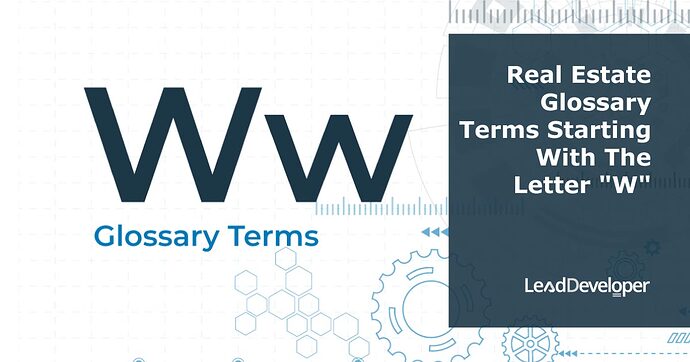Continued from…
Real Estate Glossary W [Part 1]
Wraparound lender
Assumes responsible for fulfilling debt service obligations on the “wrapped” mortgage note.
Wraparound mortgage
A mortgage that is subordinate to, but includes, the sum payable on an existing mortgage note, as well as any money to be disbursed on the new note. An all-inclusive mortgage is another term for an all-inclusive loan.
A way to pay for a home in which the second mortgage comes after the first mortgage. The second mortgage includes both the unpaid principal balance of the first mortgage and any extra money the lender gives. An all-inclusive loan is sometimes called an overriding loan or an overlapping loan.
In essence, it is an extra mortgage in which another lender refinances a borrower by giving them a loan that is more than the amount of their first mortgage. This is done without cashing out the first mortgage or making it go away. The wraparound combines two or more debts into a single obligation (like a “consolidated loan”), and the wrap, or secondary, mortgagee pays the obligations of the first mortgage from the total payments received.
The arbitrage is the difference between the two mortgage notes’ interest rates. Even though the wraparound lender pays the first mortgage’s debt service, it does not take on the first mortgage’s debt. When the wraparound mortgage goes into default, the main mortgage usually goes into default as well.
For example, let’s say a house is worth $300,000 and it already has a first mortgage for $100,000 at 7% interest and 15 years left on the term. The business owner wants to get an extra $100,000 in capital. Under traditional financing, the owner would have to refinance the building for $200,000, probably at a higher interest rate, say 11 percent, and use $100,000 to pay off the existing first mortgage and the rest for the new needs.
The owner can get a lower interest rate, say 9 percent, by using a wraparound mortgage.
The actual amount given to the borrower through the wraparound mortgage is $100,000. The new lender pays the first mortgage, which is for $100,000 and has an interest rate of 7%. The owner pays the new wraparound mortgage, which is for $200,000 and has an interest rate of 9%.
There can’t be a “due-on-encumbrance” clause in the first mortgage, because that would make it impossible to use the wraparound mortgage. When a house is turned into condos, the wraparound mortgage is a good idea because the existing mortgage usually has a lower rate than the current market rate.
Because the usury ceiling laws in many states only apply to second liens and not to residential first liens, many state laws have been changed to define wraparound loans as first liens, following the definition made by the Federal Home Loan Bank Board. So, wraparound loans can be made by institutional lenders.
A mortgage that secures a loan and includes both the existing debt’s sum due and any additional monies supplied.
Loan that permits a borrower to get more funding from a different lender or seller while still paying off their current mortgage.
Property Finance Made Easy
We specialise in Development funding | Commercial finance | Construction loans | Portfolio refinancing & Property investment loans in Australia.
Click Here to strategise with Amber
Wrapped drywall
Areas that receive a full layer of drywall, such as the doorways of bifold and bipass closet doors.
Writ of attachment
A court order prohibiting the transfer of attached property while a case is being litigated.
You are missing out if you haven’t yet subscribed to our YouTube channel.
Writ of execution
A court order that tells a court officer (sheriff or police officer) to seize and sell the defendant’s property to pay off a judgment. Before carrying out the levy, the officer may have to give notice of the sale and try to sell enough personal property to cover the debt. Most of the time, the buyer’s title goes back to the date of the judgment and is free of any liens that were made after the attachment.
When there aren’t enough assets in the district where the judgment was made, the plaintiff can get a writ of execution from a higher court that covers all of the defendant’s assets, no matter where they are in the state.
Write-off
-
Taking an asset off the books, such as a debt that can’t be paid.
-
A tax write-off.
Excess investment deductions that can be used to offset income taxes on other sources of income.
A form of accounting where a declining asset’s value is reserved or removed from the books.
Written down value
(a) For a depreciable asset, this is the amount of money left over after depreciation has been taken out of the original or historical cost. This value will be affected by: (a) the method of depreciation chosen and the value given to the asset;
(b) the amount of an asset’s cost that remains after its useful life on an organization’s books. The value of an asset at a certain point in time after depreciation has been taken into account. Also see Book Value.



